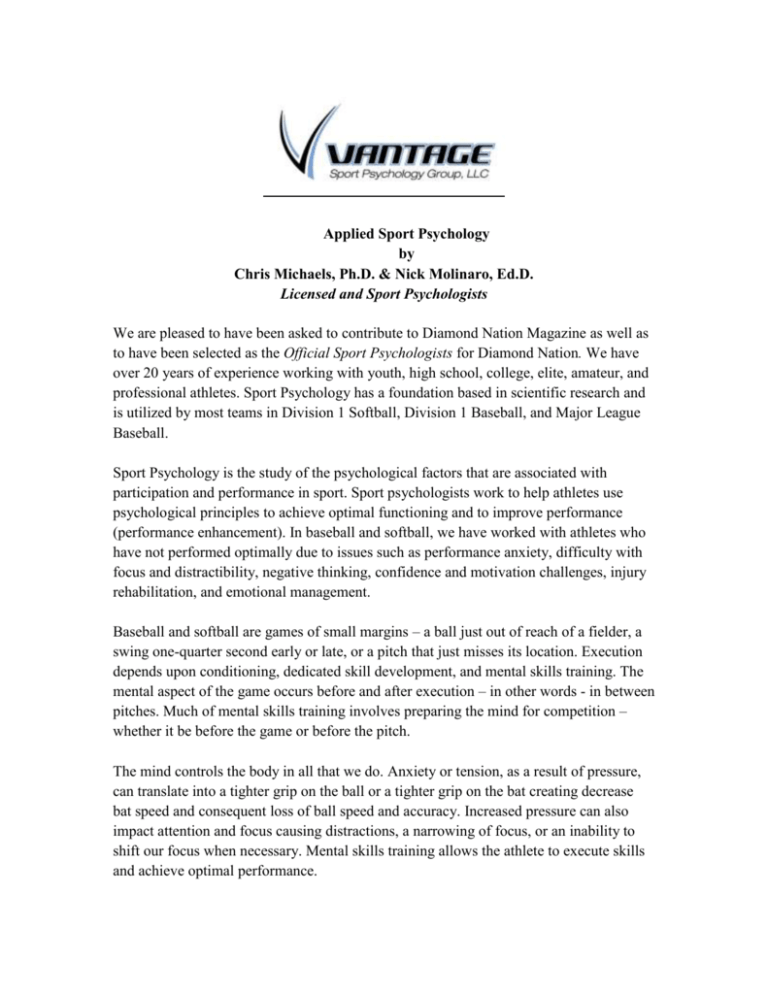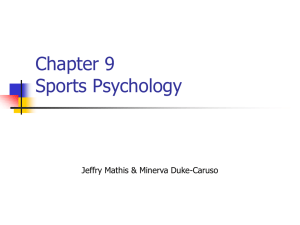Applied Sport Psychology by Chris Michaels, Ph.D. & Nick Molinaro
advertisement

Applied Sport Psychology by Chris Michaels, Ph.D. & Nick Molinaro, Ed.D. Licensed and Sport Psychologists We are pleased to have been asked to contribute to Diamond Nation Magazine as well as to have been selected as the Official Sport Psychologists for Diamond Nation. We have over 20 years of experience working with youth, high school, college, elite, amateur, and professional athletes. Sport Psychology has a foundation based in scientific research and is utilized by most teams in Division 1 Softball, Division 1 Baseball, and Major League Baseball. Sport Psychology is the study of the psychological factors that are associated with participation and performance in sport. Sport psychologists work to help athletes use psychological principles to achieve optimal functioning and to improve performance (performance enhancement). In baseball and softball, we have worked with athletes who have not performed optimally due to issues such as performance anxiety, difficulty with focus and distractibility, negative thinking, confidence and motivation challenges, injury rehabilitation, and emotional management. Baseball and softball are games of small margins – a ball just out of reach of a fielder, a swing one-quarter second early or late, or a pitch that just misses its location. Execution depends upon conditioning, dedicated skill development, and mental skills training. The mental aspect of the game occurs before and after execution – in other words - in between pitches. Much of mental skills training involves preparing the mind for competition – whether it be before the game or before the pitch. The mind controls the body in all that we do. Anxiety or tension, as a result of pressure, can translate into a tighter grip on the ball or a tighter grip on the bat creating decrease bat speed and consequent loss of ball speed and accuracy. Increased pressure can also impact attention and focus causing distractions, a narrowing of focus, or an inability to shift our focus when necessary. Mental skills training allows the athlete to execute skills and achieve optimal performance. This column will be dedicated to topics and questions in applied sport psychology and mental skills training. Let us know what you’d like to read about in this section of Diamond Nation Magazine. If you have any questions about particular aspects of your game, feel free to contact us and we can let you know some of the ways we go about conducting assessments and interventions in removing mental barriers that keep you from your optimal game. Q: My son has been frustrated by his hitting and is currently in a slump. He has demonstrated that he can hit, but this is causing him anxiety at the plate and beginning to wear on his confidence. Do you have suggestions? - Lee F. A: Yes Lee we do have some suggestions for your son. First, thank you for inquiring about this topic because players at all levels go into slumps. It is common that as a slump continues the hitter begins to press more, feel more anxious, and to change things that aren’t broken. Sometimes pressure to perform comes from within and sometimes it is the player’s wish to meet the expectations of coaches, teammates, or parents. When a hitter experiences anxiety or increased pressure several things happen. There is an increased arousal level, muscle tightness, distorted sense of time, and narrowing of attention. These all inhibit optimal performance by keeping the hitter from executing the skill sets they have learned. When a player experiences an increase in arousal level he may notice shallow or erratic respirations, increased heart rate and an increase in muscle tension. In addition the hitter will experience a distortion of time – with a sense of time moving faster. These factors contribute to a hitter’s early fatigue, slower bat speed, disruption in timing, rhythm, and reaction time. It is beneficial for the hitter to have a cue as to when he begins his pre-hitting routine. Perhaps it is when he picks up his bat or when he puts on his helmet. At this point his focus begins. Because attention narrows when a person is anxious or feeling under pressure, a hitter’s first task is to increase awareness and take notice of what his body and mind are experiencing. He may notice it in his breathing, muscle tension, or in the presence of negative thoughts. Individual players often will notice tension or anxiety in specific ways; tight jaw, clinched teeth, clenched hands, scattered focus, negative thinking. Breathing. Once the hitter has detected an arousal level or tension higher than optimal, diaphragmatic breathing (belly breathing) is the initial step. Belly breathing involves taking in a deep breath through your nose while expanding your diaphragm, holding it for a couple seconds, and exhaling long and slowly through your mouth. This gets rid of the carbon dioxide and allows oxygen to come more into play. Muscles. If you are feel the muscles in your body are tight, e.g. jaw, hands, legs put added tension in the area and then release to a relaxed state. Breathe normally and evenly as you do this until you feel the tension release. Mind. If the hitter notices that negative thoughts are keeping him from his optimal arousal state he should bring up a memory when he performed best. We suggest visualizing his at bat with as many senses as he can activate and remember the feeling after past successes. Then, he can say a few words to himself that bring him back to center; back to a readiness position. Those words are personal to each player and may be centered on concepts such as confidence, speed, foundation, or a swing mechanic. Many things can happen in the on-deck circle. The hitter can use that time to prepare both body and mind. He should expand awareness to watch the pitcher’s release point, rhythm, and tendencies and visualize the execution of the hitting plan. We suggest walk to the batter’s box – take the sign – become centered with a breath and a few key words that frame the mind – quiet the mind – see the ball – and execute. As a parent it is difficult to see your child going through a slump. While you can’t help them at the plate – you can be of assistance. Focus on the process rather than the results (e.g. hits, RBI’s). Notice and comment on quality of bats such as; good swings and contact, moving runners over, walks (seeing the ball well) and remember that a slump is defined by what has happened in the past. Baseball is played one pitch at a time. If you’d like further information, please feel free to contact us at Vantage Sport Psychology Group. Chris Michaels, Ph.D. (dr.chris@vantagesportspsychology.com Nick Molinaro, Ed.D. (dr.nick@vantagesportspsychology.com - 973-984-7510) - 973-543-0808)







